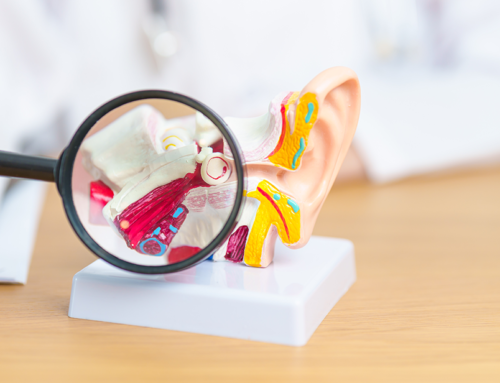Cochlear implant – still no Plug & Play
Hearing training with a cochlear implant: do you know why it is important? Further development of the cochlear implant technologies brings not only more natural sound and better speech understanding possible, but also much faster hearing adaptation. Nevertheless, hearing therapy after implantation is advisable and enables even better success with this hearing system.

Conventional hearing aids amplify sounds to a certain extent, but they are not sufficient for people with profound hearing loss or deafness. Cochlear implants directly stimulate the auditory nerve. This enables people who have profound hearing loss to hear. The nerve impulse obtained in this way is similar to natural hearing signal, but the central hearing system still requires some adaptation to it.
In the last decades, the hearing technology has significantly improved. This is reflected in natural sound image with the CI, as well as in better and faster speech understanding. However, cochlear implant does not belong to plug and play technology, that we are accustomed to through the modern computer technology.
Why is hearing training necessary?
Our hearing system already works in unborn babies from the 24th week of pregnancy. If a baby is born deaf or hard of hearing, he or she will not only have to catch up with the speech development before receiving a hearing system, but also with prenatal development. Of course, the earlier hearing care is provided, the less therapy is required. First communication exercises are useful, even before hearing implantation.
Data shows that adults who are deaf also benefit from hearing rehabilitation after cochlear implantation considerably. Referring to one older study from the Koblenz-Montabaur clinic [1], Dr. Roland Zeh, chief physician at the CI Rehabilitation Center in Bad Nauheim, Germany, and Prof. Dr. Uwe Baumann, audiologist and CI specialist at the University Hospital in Frankfurt, Germany, add following: “To ensure optimal treatment success, inpatient rehabilitation measures should be an integral part of a holistic treatment approach and, if possible, should take place in the first year after implantation.”
What are the benefits of a hearing training?
In a study [2] involving 1,355 CI users, Prof. Baumann and Dr. Zeh investigated which factors influence the success of such inpatient hearing rehabilitation. They summarize that “On average, [in the hearing and speech comprehension tests after three to five weeks of inpatient rehab] there was an increase of 20 percentage points compared to the admission test”. What was surprising was that those older patients, who were implanted after longer period of deafness as well as patients with many years of CI experience also showed significant improvements as a result of the rehab interventions.
Earlier studies had suggested that, on average, CI users did not experience further improvements in speech understanding after about six months of CI experience. Nevertheless, Zeh and Baumann were able to demonstrate that, “The best possible support […] is not achieved by longer CI use alone.”
Even if these factors have an influence on the speed and extent of hearing improvement through therapy, they add that “all patient groups benefited significantly from the therapy, regardless of age, duration of deafness or duration of CI use. […] CI fitting can lead to improvements in activity, participation, and quality of life. Without intensive rehabilitation, there is a risk that these results will not occur to the greatest possible extent.”
What is hearing training?
Hearing development in the context of (re)habilitation occurs in five basic steps, whereby individual steps can also be skipped depending on individual speech comprehension:
- Perceiving, distinguishing and classifying sounds.
- Recognizing speech, understanding words and sentences; in children, also speaking
- More complex language units: new and more difficult words, grammatical structures, telling stories and communicating (verbally) in everyday life
- Strategies for communication in particularly difficult listening situations
- For the so-called binaural functions – understanding in noise and sound localization – hearing with two sides is a prerequisite. Also, the ears are practiced separately.
Additionally, the instructions on how to handle and take care of your hearing device is also part of the rehabilitation. In the case of inpatient hearing rehabilitation, support from other therapists as well as psychotherapists and social workers is also possible. Moreover, the networking of the affected is promoted.
Where can I find offers for hearing training?
Basically, any auditory sensation can be practiced. Experts recommend listening exercises on a daily basis. In a structured hearing therapy, speech therapists assess the current hearing status of the respective user, show him and his practice partners how to continue practicing at home, and provide suitable practice material.
You can contact us here and find out more about the hearing rehabilitation and early support possibilities in your country. Also, tips and practice materials, as well as special practice apps for smartphones, tablets and computers, are offered by hearing aid and hearing implant manufacturers, among others.
How to understand each other better
Tips and simple rules for better communication with and without hearing problems
Some situations, like conversations in noisy environments, in larger discussion groups or in foreign languages can be really challenging. We have compiled some principles on how to facilitate communication in everyday life.
In the school classroom, in the office, living room or other common areas, it makes sense to optimize room acoustics. Hard, smooth walls lead to reflections, thus increasing the noise level and making conversations more difficult. In the conversation situation itself, simple rules help:
- Minimize background noise: turn down the radio or other devices, close windows, do not handle dishes while talking etc.
- If possible, write down names, new terms, dates and other important information.
- Use available additional devices
- Let the conversation partner talk and do not interrupt each other
- Look at the person you are talking to and do not cover your mouth
- Even with emotional topics or if you repeat something: do not shout or overemphasize!
- Speak clearly and not too fast
- Do not speak with your mouth full – avoid chewing while speaking, this also applies to a chewing gum
- In case of uncertainty, ask questions or repeat what you have heard to confirm it is correct
Speak clearly
Shouting, as well as monotone, artificial or exaggerated pronunciation make speech comprehension even more difficult. This can become better if you:
- Speak accurately, precisely and in full sentences
- Speak lively, with full range of vocal articulation
- Emphasize keywords
- Make clear pauses between all phrases and sentences
If you try to express yourself clearly, you will automatically speak slower and a little louder.
Ask questions
No one likes to “cause trouble” and annoy others with constant questions. However, misunderstanding can be exhausting for both conversation sides. That´s why asking questions is in the interest of both conversation partners:
- Say it again/slower, please!
- Please say it differently!
- What is it about? Give me a clue, please!
- Spell/write the most important word, please!
[1] Maurer, J. Gegenwärtiger Stand der Cochlea Implantatversorgung bei Erwachsenen und Kindern. HNO 57, 693–706 (2009). https://doi.org/10.1007/s00106-009-1959-3
[2] Zeh, R., Baumann, U. Stationäre Rehabilitationsmaßnahmen bei erwachsenen CI-Trägern; Ergebnisse in Abhängigkeit von der Dauer der Taubheit, Nutzungsdauer und Alter HNO 2015 · 63:557–576 (2015). https://doi.or/10.1007/s00106-015-0037-2






